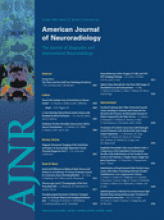Abstract
SUMMARY: A case of a congenital solitary internal carotid artery with complicated anastomosis is presented. This rare anomaly was an incidental finding at cerebral angiography in a patient with a poor-grade subarachnoid hemorrhage and a ruptured anterior communicating artery aneurysm.
We describe a case of a congenital solitary internal carotid artery arising from the right side in a patient with a poor-grade subarachnoid hemorrhage and a ruptured anterior communicating artery aneurysm. There was also complete occlusion of the proximal right middle cerebral artery with collaterals reconstituting the terminal branches of the right middle cerebral artery. Such findings are extremely rare.
Case Report
An 81-year-old woman presented with sudden collapse. On admission to our institution, the patient was unconscious. The Glasgow Coma Scale score on examination was 9/15. Blood pressure and pulse were stable. Noncontrast cranial CT findings were diffuse subarachnoid hemorrhage (SAH) and moderate hydrocephalus. An emergency operation with an external ventricular drain was inserted to treat the hydrocephalus.
Because of the finding of diffuse SAH in a patient without a history of head injury, CT angiography and subsequent conventional angiography were performed because a ruptured cerebral aneurysm was suspected. The angiograms showed that the solitary internal carotid artery arose from the right side (Figs 1 and 2), and the left internal carotid artery was absent from the left common carotid injection. The right internal carotid artery turned leftward after its exit from the cavernous sinus. The solitary internal carotid artery supplied both anterior cerebral arteries. There was a small aneurysm at the anterior communicating artery, measuring 2.6 × 1.6 mm, with a daughter sac at its fundus, forming an L-shaped configuration. The proximal right middle cerebral artery was completely occluded with collaterals reconstituting the terminal branches of the right middle cerebral artery. The left middle cerebral artery was supplied by the vertebrobasilar system through a large left posterior communicating artery. Venous structures were unremarkable. The absence of the left carotid canal was shown on bone window settings.
Frontal view of right internal carotid injection shows the solitary right internal carotid artery, Moyamoya phenomenon of the right middle cerebral artery, and anterior communicating artery aneurysm.
Lateral view of right internal carotid injection shows the right ophthalmic artery and an infundibulum at its origin.
The aneurysm was very small and wide-necked and thus was not suitable for embolization. The patient’s condition continued to deteriorate, and she died 15 days after admission, with pneumonia.
Discussion
Agenesis of the internal carotid artery is rare.1 “Agenesis” refers to the total absence of the entire artery due to an embryologic arterial developmental failure. “Aplasia” denotes that vestiges are present, and “hypoplasia,” that the vessel is present but small. The key to differentiation is to use the CT bone window setting to assess the presence of the bony carotid canal, which is absent in the case of agenesis. Agenesis of the internal carotid artery is associated with vascular anomalies such as cerebral aneurysms and abnormal collateral channels. There were 6 reported cases in the literature associated with anterior communicating artery aneurysm,2–5 as in our case. The aneurysm formation was thought to be flow-related in these cases. In our patient, the solitary internal carotid artery supplying both anterior cerebral arteries was an example.
This patient’s contralateral middle cerebral artery was supplied by the vertebrobasilar system through a fetal-type posterior communicating artery. The other possibility reported in the literature was through a transsellar route. The embryologic basis of the transsellar carotid route was suspected to be from persistence and fusion of primitive maxillary arteries. Normally, the primitive maxillary artery is present in early development and then regresses to the posteroinferior hypophyseal artery. It usually arises from the medial surface of the vertical portion of the carotid siphon and supplies the posterior hypophysis. It may arise from a common trunk together with the trigeminal artery; their common remnant will then be a single artery that arises from the vertical portion of the internal carotid siphon, the meningohypophyseal trunk.
The patient’s occluded proximal right middle cerebral artery was coupled with a well-developed anastomotic network to reconstitute the distal right middle cerebral artery. This probably represented an atresia with the persistent primitive plexiform network. The rich collateral network would favor a congenital etiology and was classified as a Moyamoya phenomenon with its localized involvement. There were 10 other cases reported in the literature, but this case was unique in its association with the solitary internal carotid artery.6,7
Conclusion
To our knowledge, this case of a solitary internal carotid artery associated with an ipsilateral middle cerebral artery Moyamoya phenomenon represents the first to appear in the literature. This anatomic variant would be of clinical significance in cases of surgical or endovascular intervention.
References
- Received September 26, 2005.
- Accepted after revision October 27, 2005.
- Copyright © American Society of Neuroradiology














